April 28 - May 4, 2024: Issue 623
THE EARLY YEARS OF BUNGAN BEACH SURF LIFE SAVING CLUB - THE CALL TO BUNGAN
BY W.E. ANSCHUTZ
(Bill Anschutz)
Bungan SLSC's 71st Season
Roger Johnston, a resident of Bungan Beach, forwarded the following to Pittwater Online News as the last week of the Volunteer Patrol Season began. As today, April 28 2024 is that final day for the 2023-2024 Season, there can be no more fitting tribute and celebration than taking an opportunity to share an insight into that great surf club tucked between Mona Vale and Newport that began keeping people safe during the 1952-1953 Season.
Roger said:
My family have resided at Bungan Beach since 1925. We owned an old stone cottage next door to the Yewen property up on Bungan Headland. It was the family weekender.
I have attached two photographs taken in 1961 by my father from Bungan House showing the film crew on the beach for “Bungala Boys”, made for the British Children’s television foundation. It was all about selling Australia I expect. The surf boats you see in the photo were invited from all the local surf clubs on the peninsula to compete in a mock up surf boat race. Two army ducks were brought down and one was rigged with a frame to mount the camera as the boats all raced out through the surf whilst the duck raced with them filming across the action.
In addition to that I have attached a short story titled “ The call to Bungan” that my Uncle Warwick Johnston, Bungan Beach Surf Club founding member, gave me before he passed away. A great little story about the history of Bungan Beach surf club by one of his good friends Bill Anschutz, also a founding member.
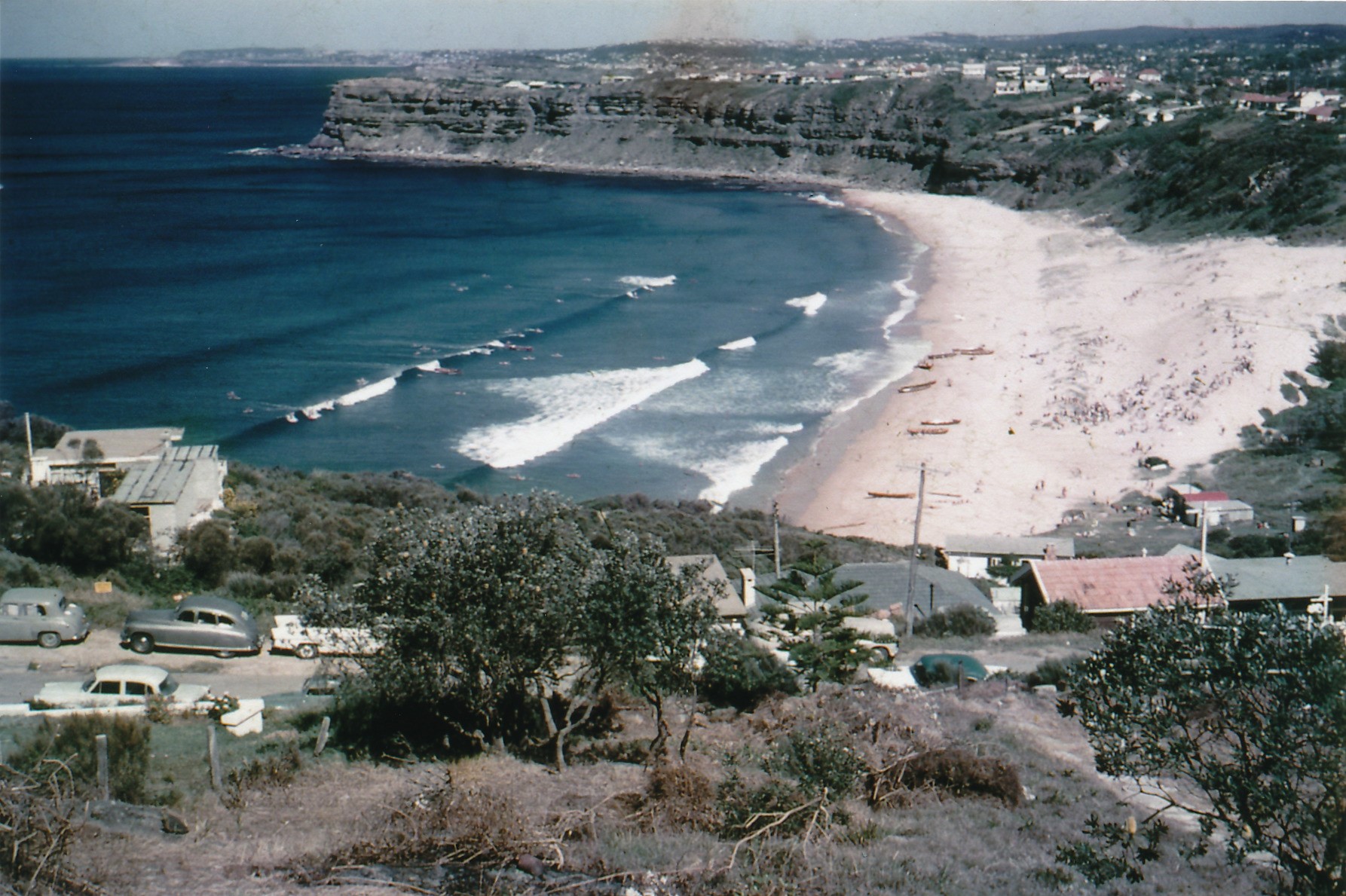
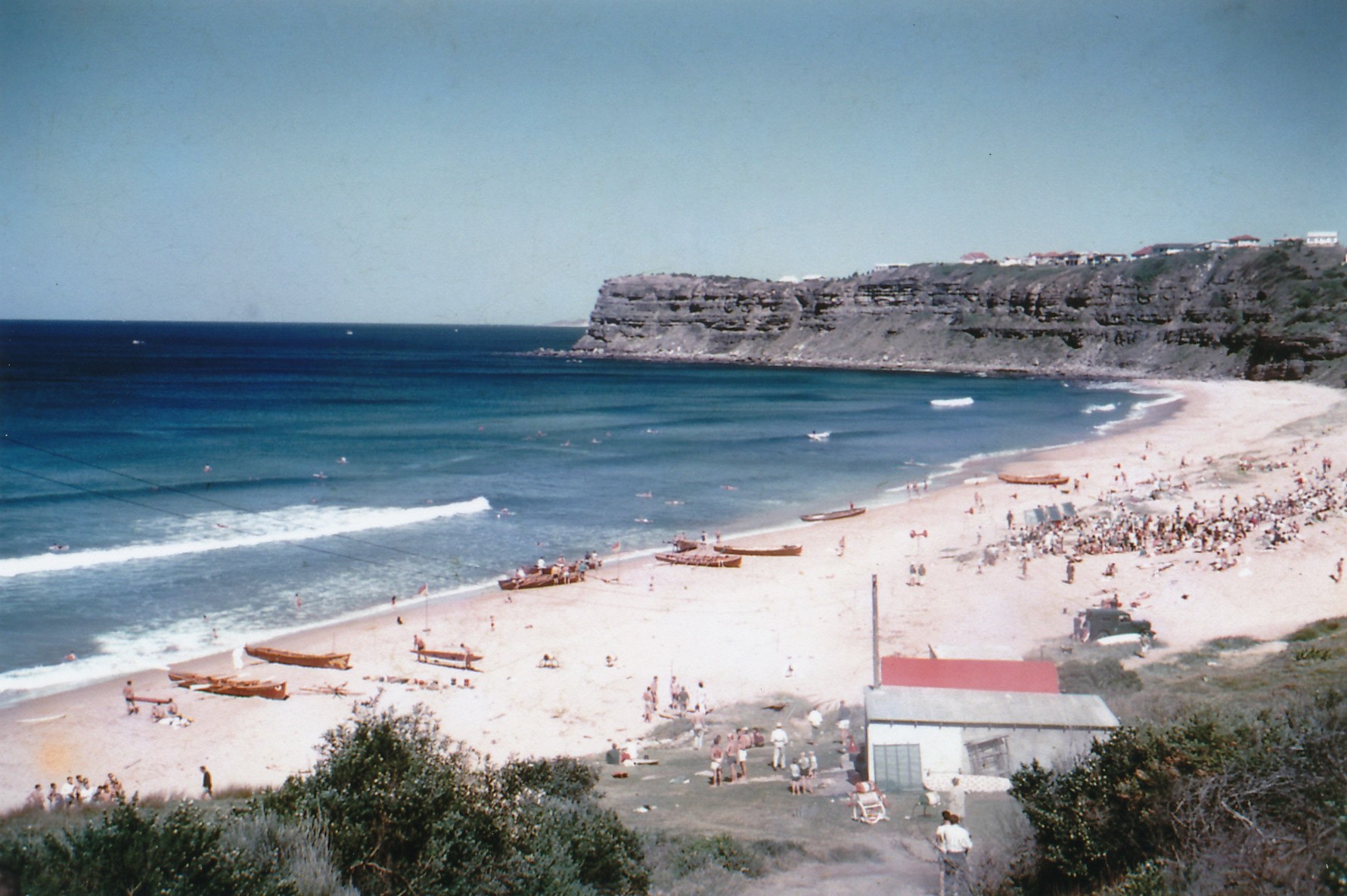
Laurence Johnston's pictures taken during filming for “Bungala Boys”, - details of this ran in a Women's Weekly article (added in after The Call to Bungan)
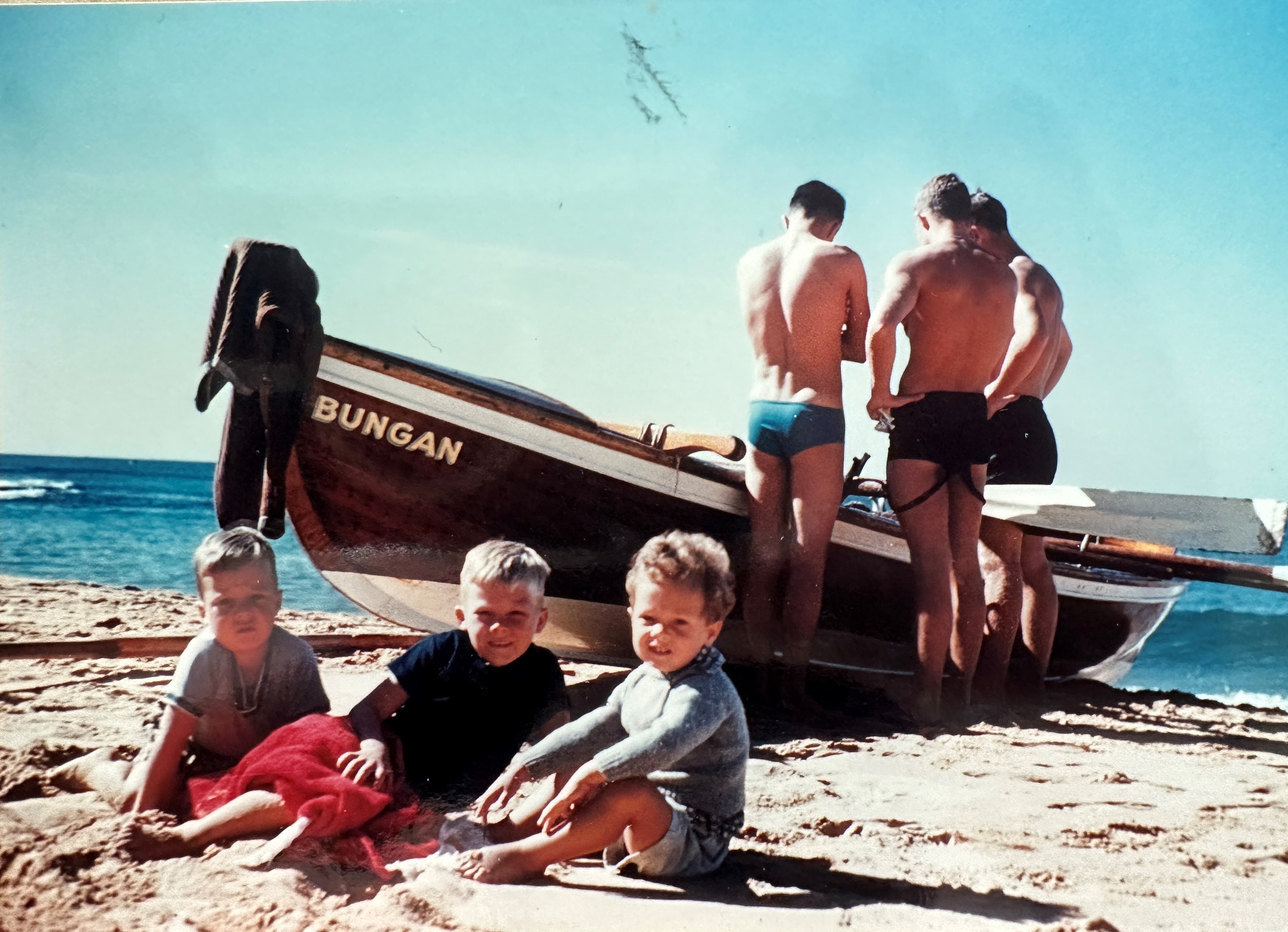
Growing up at Bungan. 1960; My mother was the budding photographer. My brothers left to right Hugh, Mark and myself.
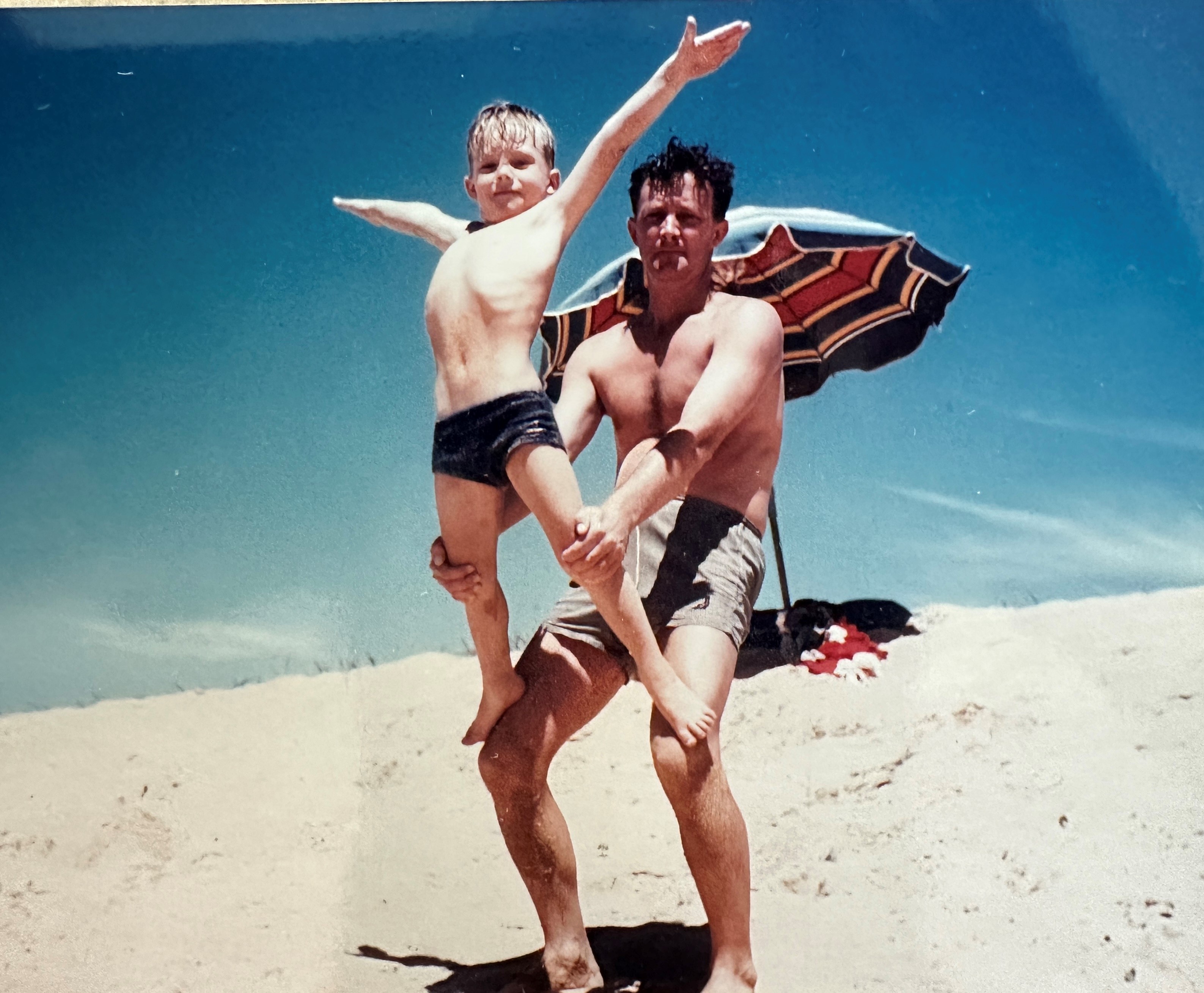
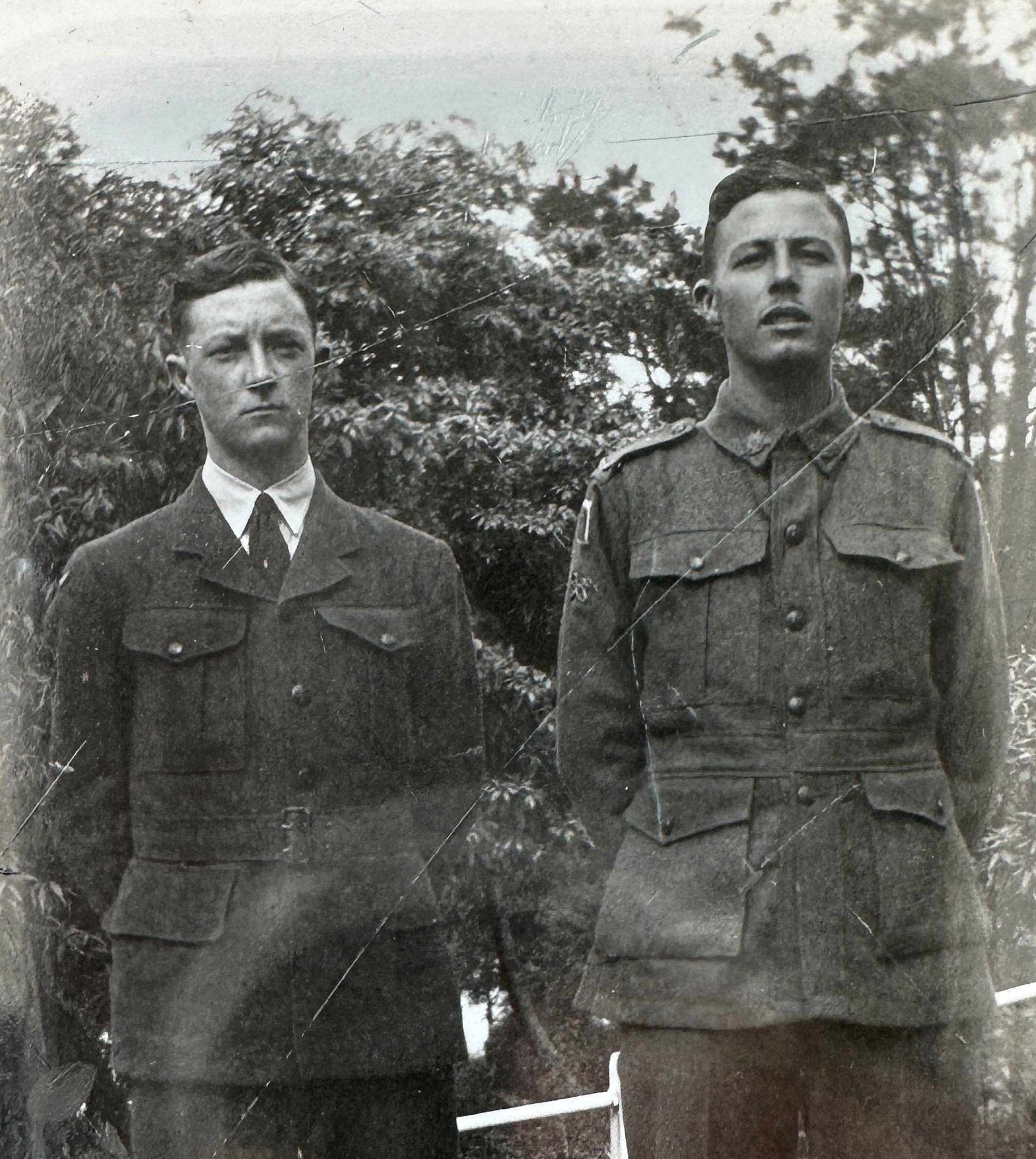
Photo: Laurence Johnston and Warwick Johnston (right). 'Warwick left Sydney after the war to go to QLD and become a cattle farmer. I only saw him once every few years.' Photo and background by and courtesy Roger Johnston, Bungan House, son of Laurence
THE EARLY YEARS OF' BUNGAN BEACH SURF LIFE SAVING CLUB
BY W.E. ANSCHUTZ
(Bill Anschutz, a founding member)
FORWARD
The Call To Bungan
All those who have stood on the cliffs and headlands which surround Bungan Beach will know the excitement and grandeur of the beach and surf. This private and inaccessible beach with its everchanging sandhills, natural bush and rocky headlands is something different to each of us. However, we all share the infection of this piece of nature which carves its impressions into our memories and binds us to return.
Part of the fascination lies in the knowledge that the restless surf, with its gentle waves, clear water and balmy surroundings will change into a fierce, thundering and awesome cauldron, carrying all before less power. it with naked and relentless power.
It is as though nature issues a demand that it shall not be taken for granted and that all who enjoy its benefits, shall also pay homage to its strength and power. This capsule of nature that is Bungan has its own identity, its own temperament and its private lovers, married for life.
Such are the members of Bungan Beach surf Life Saving club.
Getting Started
From the early part of the century when Barrenjoey Road was pushed through to Newport and Palm Beach, people have swum at Bungan and it 'is somewhat surprising that a Surf Life Saving Club was not finally established until the 1952-53 season.
This is not to say that attempts had not been made, however with the exception of a group of people who tried to establish their own independent life saving group in the 1940's, other attempts are obscure and may not have even germinated past a ‘want' in peoples minds.
The inevitable climb back through the bush track in the centre of the beach to Barrenjoey Road on the slippery black soil track (which is in fact Myola Road) to Bungan Head Road, and the lack of surf life saving patrols added to the image that Bungan was unsafe for surfing. The result was that the beach was left well alone, except for secluded amorous interludes by day and barbecues at night.
The commencement of building again, after World War II brought additional residents to Bungan with families who needed protection on their 'private beach'' The J. Stanley Johnston (music shop retailers in Sydney) family had for years owned a stone weekender on the summit of the north headland and Warwick, a son, had built himself a home on the south headland. Bob Roberts' a young and hard working builder had built a garage on his land on the north headland ridge on Myola Road and with young children, was looking for safety on the beach whilst he gradually built his new home.
Ari van Rees, a Dutchman with his beautiful wife Ami and three year old son, lived on the south end in a large house (now burned down) and being a devotee of Bols gin (or any gin for that matter) had many parties which brought the locals together. The subject was discussed at length again and again but a catalyst was needed.
Rus Ames, a Surveyor and council engineer, and Gill Stone, married to a beautiful and charming girl who had worked as model (Janice Mahoney) were also great friends of the Van Rees and keen for a start.
The idea was there, but how to get started?
Whilst the development of the community at Bungan went on, a staunch bunch of dedicated surfers travelled backwards and forwards on double decker buses to Newport, Bilgola, Avalon, Whale Beach and Palm Beach and of these the Avalon boys would took out of the top window as they passed Bungan to judge what sort of surf would await them at Avalon as it was commonly believed that both beaches shared a similar size and style of surf.
One of the Avalon members was Max McCredie, an experienced surfer with 'salt water in his veins’ a member of Collaroy S.L.S.C. prior to World War II, who graduated to Avalon for the type of surf it offered. It was Max’s cool and quiet challenge "lets take the boat out and crack a big one" that brought him undone in Avalon for he rallied a scratch crew who launched the 'double-ender' into a big sea and rowed for their lives to get out through a short break. The boat was about half full of water when they spun around and Max on the sweep called "Row for this one". The water in the boat made it sluggish and the wave passed under them bringing them into the 'dropping zone'.
There was no doubt about the next wave. It towered behind them and was starting to break in a wall of foam when Max called to the crew "You can come aft if you like". Four frantic bodies clawed aft as the stern lifted sharply and the water in the boat rammed forward like a lead weight driving the bow down in a straight line to the bottom. When the boat was finally brought ashore it had a broken keel and as it had been used without authority, Max was called up before the Avalon Committee to show cause why he should not be suspended. The worst happened, and Max’s thoughts turned to Bungan where he had swum from time to time.
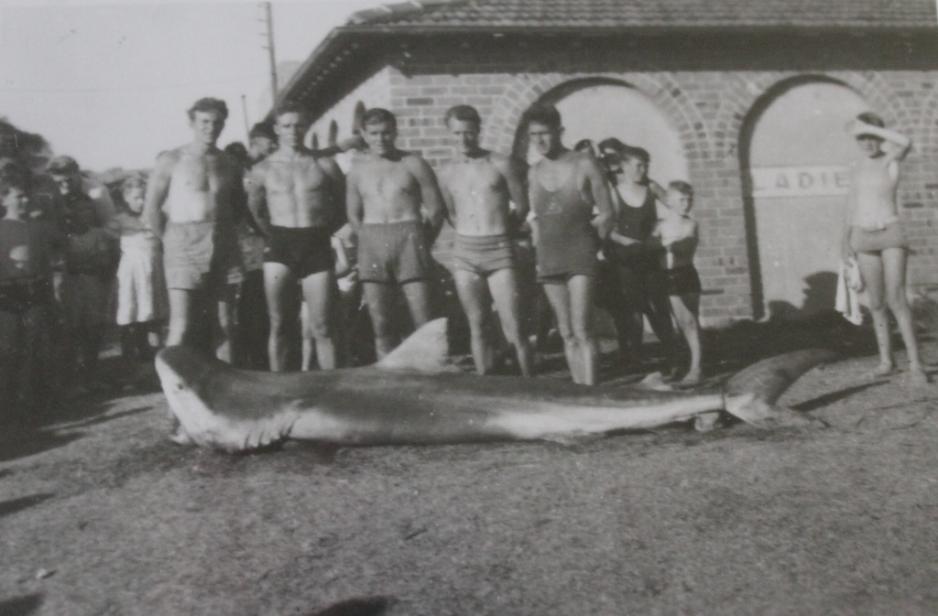
Left to right; Jim Campbell, Max Watt, Brian Sheehan, Geoff Gearside and Max McCredie, ***December 1949. Photo courtesy Watt family.
Whilst chatting with a local resident, Noel Burton, the thought surf club came up and Noel knowing the other locals spoke with Johnston(an ex-Newport member)about the action necessary to move. A meeting of interested people was held at the home of Ari Van Rees in January 1955. The meeting resolved to approach the Sydney Branch of the Surf Life Saving Association and ask for their assistance. A meeting was then called on the last Friday of February 1953 as the S.L.S.A. had arranged for the district supervisor, Mr L.E.(Laurie)Payne to attend.
Laurie, a life member of Newport surf club as well as being a member of the Board of Examiners, was the obvious choice for chairman and was elected to conduct the inaugural meeting. The meeting was attended by –
W. (Warwick) Johnston
W' E' (Bill) Anschutz
N. (Noel) Burton
R' (Russell) Ames
P. (Peter) Burton
A. (Arthur) Lumsden
A. (Ari) Van Rees
A. E. (Bob) Roberts
M. F. (Max) McCredie
L. E. (Laurie) Payne
H. (Harry) Kelly
And the following officer bearers elected –
L. E. Payne - President
W. Johnston - Secretary
N. Burton – Treasurer
The new committee resolved to seek affiliation with the S.L.S.A.. After some discussion and the expression of two distinct view points, namely that the locals really only wanted protection for themselves and their families and did not want the full involvement that affiliation with the S.L.S.A. entailed, and the formation of a sporting club prepared to patrol the beach in return for the comradeship and competition traditional in surf clubs.
Laurie Payne, Warrick Johnston and Max McCredie, knowing that adequate protection could only be provided with regular patrols and proper surf life saving equipment, argued strongly. Perhaps the failure of the last attempt to form a club, because of their refusal to affiliate with the S.L.S.A. won the point and Laurie Payne, who had been involved with the offer to help the previous attempt, brought home the point that there could be no compromise. As stark and unchangeable fact about life saving in the surf.
On 7 April 1953 Bungan Beach S.L.S.C. was officially affiliated with the Sydney Branch of the S.L.S.A. and the newest and smallest club in the Metropolitan area of Sydney became a reality.
Just prior to affiliation on 27 March 1955, the group of interested people had grown to 13 and new responsibilities were assigned, with the committee taking shape for the remainder of the current season. The new team looked business-like with appropriate responsibilities being taken over by members with experience in specific areas.
Laurie Payne - President
Bob Roberts - Secretary
Warwick Johnston - Captain and Chief Instructor
Noel Burton - Treasurer
Rus Ames - Social Secretary
Gil Stone - Publicity Officer
Max McCredie - Delegate S.L.S.A.
Peter Burton - Delegate S.L.S.A.
A building committee was also formed and Bob Roberts, Rus Ames and Warwick Johnston were to investigate the erection of a suitable club house.
The club appointed a patron one month later -; none other than the Newport Ams licensee, K. C. Ryan, who responded with a £25.00 donation - a sizeable sum in those days.
One of the more important functions needing attention was the drafting of a constitution and after considering several constitutions from other clubs, Mr. S. R. Fayle accepted the task. Using Newport's constitution as a basis he drafted a new that was presented to the committee on 31 July 1953. The draft was later adopted at the First Annual General Meeting and with minor modifications only, has remailed substantially as he left it. A necessary document and one that has been tested over the years.
Having committed past the point of no return, the committee was anxious to get on with the task of developing the beach and expanding the club. The difficult access to the beach seemed to be a problem that would hinder progress, particularly the erection of a club house. They also recognised the need to attract new members get part to attract new members who were prepared to climb up the hill after a hard day of surfing, or even worse, a hard night of barbequeing.
Laurie Payne undertook to approach Warringah Shire Council with a request that they put an access road into Bungan. The club also sought approval for the new club and a club house.
We waited in great anticipation for the reply, but our hopes were dulled when we finally received the reply that council would not raise any objection to a surf club being established at Bungan, nor would they help with any financial support or development. The matter of an access road into the beach was to be considered in the 1954 Works Programme. Obviously this project never got past consideration in the Works Programme and in the long term it has been this lack of development which has preserved the character of Bungan.
The club was rapidly finding its direction under the guidance and experience of Lauire Payne, who steered the initial enthusiasm and energies of the members towards the aims and objectives of vigilance and service.
There were many occasions where Laurie’s maturity and experience, in surf saving and as a chairman, pulled together the practicalities of the ideas that were floated at the meetings, so that rational decisions were forged, keeping progress steady but forward.
In June 1953, Gil stone resigned as Publicity Officer and the task fell to Mort Chapman, a young dentist who had recently graduated after completing a repatriation University course following the end of World War II.
In the autumn of 1953,south Narrabeen S.L.S.C., hearing of the formation of the new club loaned Bungan a reel line and belt and as this was to be left out on the beach continually. Roy C. Davis, a resident from Hillcrest Avenue, offered the club a small shed as a shelter. This was erected in the sand hills about 100 metres south of the centre track from Barrenjoey Road.
The inauguration of a new club was indeed something special in Metropolitan Sydney as it was thought by most people that all beaches were patrolled and all other surrounding clubs well established (some going back to 1907). Yet here was a rare opportunity to become a foundation member of one of the last unpatrolled surfing beaches in Sydney.(Certainly Narrabeen Club came later, but North and South Narrabeen were also in existence).
The date of 30septernber 1953 was set as the closing date for Foundation Membership and the members to bear that honour were –
Anschutz (Bi11) W.E.
Ames (Rus) R. W.
Burton (Peter) P. H.
Burton (Noel) N. S.
Chapman (Mort) S. M.
Fayle (Tom) T. W.
Fayle (Roy) S. R.
Flowers (Frank) F.
Johnston (Warwick) W. G.
Lumsden (Arthur) A. R.
McCredie (Max) M. F.
Payne (Laurie) L. E.
Roberts (Bob) A. E.
Wallace (Bob) R. B.
Support for Surf Life Saving Clubs was scant in the 1950’s, until the Sydney Morning Herald launched a major appeal to establish a fund for the purchase of life saving equipment and after representation to the Sydney Branch meetings in the old headquarters in Hunter Street, Sydney by Laurie Payne, the committee, and by delegates to the branch meetings, the club was notified in September 1953 that a stretcher and 5.0.0. of First Aid gear would be allocated from the 'Herald Gear Fund". A surf ski and reel line and belt were also to follow and we were well and truly in business now.
The new ski, a 12ft. Robson, was wide with plenty of "banana" and light but easy to manage so that it was readily used to patrol the beach and stand off the swimming buoy during surf races and bronze training.
The first bronze squad was training one Sunday morning when Mort Chapman, who was keeping a watchful eye on the patient Bob Wallace and beltman Rus Ames in the belt, raised the paddle vertically signalling "shark". The ominous shape was cruising below Bob's feet when he heard Mort's shout and saw the paddle go up. There was no second call needed. Bob covered the 10 metres towards Mort on the ski in 3 strokes and leapt out of the water towards the ski. Mort’s reaction was quick and firm "Get on slowly or I will hit you on the head with the paddle". Bob climbed aboard carefully but quickly and the tandem riders paddled carefully to the shore trying not to catch a wave.
Rus Ames, swimming in the belt about 100 metres offshore, saw the signals and heard the shout. Needing no further encouragement to abandon his objective, Russ swam like a frantic butterfly maintaining a planing angle whilst being hauled across the top of the water as fast as the beach crew could tow him. Those on the beach breathed a silent relief that they were not in Rus Ames place. Training was cancelled for the rest of the day.
The squad gained their awards at Avalon -
M. F. McCredie - Instructors Certificate
S. M. Chapman - Instructors Certificate
R. W. Ames - Bronze Medallion
W. E. Anschutz - Bronze Medallion
A. Gourlay - Bronze Medallion
R. Degotardi - Qualifying Certificate
E. Terrell - Bronze Medallion (Dee Why 11.4.54)
This squad was not all comprised of strong swimmers, but acts of great personal courage are not confined to the best swimmers. One of the most outstanding demonstrations of endeavour must be that of Bob Degotardi, who, being a relatively poor swimmer, must have dreaded his turn in the belt, yet he was seen to make up a harness which allowed him to tow a four gallon drum, partly filled with water, whilst swimming laps of the Newport Pool, to increase his stamina. Bob never succeeded in gaining his bronze but made a significant contribution in raising money for the club.
Because of the limited number of people who swam at Bungan in 1953, patrol duties were not as demanding as other beaches with the result that most members swam together and a 'club wave' was always on. Surfcraft were limited to a ski owned by Warwick Johnston, but this finally disintegrated on a wave, with the bottom sheet of plywood peeling off, leaving only the sides and deck to bear Mr. Johnston ungracefully into the sand.
Max McCredie, Rus Ames and Mort Chapman all built skis soon after whilst Warwick Johnston bought a ‘Wallace’ 16ft surf board, and Bill Anschutz built a 12 ft board, which weighed around 70 lbs. and was almost impossible to ride. It did however weather the elements well as the only storage was in the sandhills.
It was not until the 1953-54 season that Max McCredie and Warwick Johnston, both excellent swimmers without fear and good on a wave, suggested that the club commence handicap surf races to keep fit and maintain interest.
The date of the first surf race was not recorded, but it was swum in the centre of the beach around a can moored sone 200 metres off shore. This was prior to our having the new club ski and after Warwick Johnstons plank has disintegrated. Warwick placed the can by swimming out through the waves and throwing the four gallon over each wave as it approached. Warwick continued to do this each week until finally he did not throw the can high enough and the approaching wave caught it, smashing it against his forehead leaving a deep gash.
Max McCredie usually swam out with a small sandbag and line which he attached to the handle of the can after it was through the broken waves. This became the swimming buoy.
On the day of the first surf race a medium sea was running as they set out swimming at full speed. There was no sign of a rideable wave and Max and Warwick were slightly ahead and close to the finish when a small wave loomed behind Bill Anschutz, giving him a ride long enough to lob about two metres, in an unbeatable margin at that point. To mark the occasion Max McCredie presented a silver cup suitably inscribed.
The need for a shelter of some description became more pressing and it was finally decided to buy a caterpillar tractor case and use this to keep the few pieces of gear protected from the elements. The case was deposited at the top of the centre track near the corner of Barrenjoey Road and Karloo Parade. The centre track was winding and completely overgrown with the tea tree and lantana forming a roof of matted bush. The only way that the crate would get to the beach was by club members manhandling it along this track.
The members sweated and strained, lifting and pushing the crate steadily forward. Finally, after a weekend of blood and guts effort the crate 16ft x 7 ft was erected in an inverted position on four brick piles.
The inverted crate was later replaced by an ex-Army Nissen hut which was to serve for the next 15 years. The second clubhouse, as it was then known, became a dressing shed, sleeping shelter and storage shed for the members.
Warwick Johnston resigned as club captain in 1954 being replaced by Max McCredie.
There was so much to do in a young club that most members spent their complete weekends at the beach, working on the clubhouse and surfing, training, competing in local carnivals and developing the beach. Typical of the enthusiasm was Warwick Johnston’s contribution where he towed his bulldozer to Bungan Head Road and graded the narrow uneven track which forms the lower end of Myola Road and is the main access to the beach. Even with this activity, patrols were maintained and the safety so earnestly desired by some of the local residents with young families, was now a reality.
Growth in membership was slow and with almost no local population, came from other areas. After the foundation members came a group from Willoughby who comprised the major portion of the 2nd Bronze Squad. Alan (Peanut) Park - Qualifying Certificate, John (Mouse) Nelson - Qualifying Certificate, George (Buddy) Pearson - Bronze, who carried their awards together with R. Lowell, Bronze, under instruction from Bill Anschutz who also gained a further instructors certificate.
The continuous responsibility for patrolling the beach placed increasing pressure on the original members and conflicting family obligations as well as the inflexible demands for physical fitness through regular participation in surf races, brought about resignations and retirements.
Of the original 14 foundation members, the only ones remaining were Anschutz, Chapman, McCredie and Payne and the task fell heavily upon them for provision of continuous patrols, as safe bathing for the increasing number of people discovering Bungan was now a growing responsibility.
The initial surge of the club had come to a lu1l but the more important realisation that a club charged with the responsibility of life saving disciplines could have no compromise, grew stronger in the resolve of those that were left.
Those who argued so strongly for affiliation of the new club with the S.L.S.A. in February 1953 had little knowledge at the time of the fatefulness of that commitment which had now placed a heavy load on each of them. None who made that commitment would be the first to let go. Each resolved to keep going regardless of the difficulties. To lose all that had been achieved was unthinkable - and the club went on.
To imply criticism of those who started with the club and did not or could not continue would be unfair. Each made a contribution in time, enthusiasm and effort and in some cases the effort was more than generous. Whole families were involved and the composite efforts of all built a foundation and tradition of which all members, past and present, have been the beneficiaries.
The Clubhouse
The present Clubhouse is built on Myola Road and the only practical site on the beach. Controversy has surrounded the location which has been within the reach of giant seas on at least three occasions, two of which resulting in the Clubhouse being partially demolished.
As far back as L920, Warringah Shire Council provided public dressing sheds on Bungan, but for some 50 years in between there had been no Council buildings to serve the public or provide shelter for Surf Life Saving Gear. The erection of a suitable building was a main preoccupation with the club for the first eighteen years and only then after a continuous campaign for five years did the Council agree to build the modest facilities now in existence.
The lean-to shed donated by Roy Davis in 1953 was shelter only for a reel, line and belt, and the Caterpillar Tractor Case which followed in 1953-54 was more of a monument to the ingenuity and endeavours of the members who wrestled it down on to the centre of the beach after requests to the Army to bring it to Bungan on an amphibious duck were declined. It did serve well as a backdrop for some of the barbeques which raised funds for the club in 1953. Obviously the tractor case was not destined for a long life and the committee approved a building fund and appointed a sub-committee to enable better premises to be built.
The site was critical and alternatives were limited. The only sites available were on Myola Road and the property adjoining the western boundary of Myola Road but it was clear that the Morrisons, who were nature lovers and had sacrificed gas and electricity and water supplies to their timber house hidden in the bush, would not be pleased to have any sort of building on the bottom of their property. In fact, to keep intruders out the natural bush and sea of freesias which blossomed in Spring, a fence was a silent reminder of this wish. The Morrisons later made a gift of the land to the NSW Government for preservation as a flora and fauna sanctuary and this bears witness to their integrity.
Whilst the club looked jealously at the land on many occasions the current situation is probably the best compromise.
Limited resources curtailed any grandiose ideas of building and one day Jim Forsyth an estate agent in Willoughby told Bill Anschutz of an ex-Army Nissen Hut erected in the backyard of a house in Roseville. McCredie and Anschutz called at the house that week and it was found that a family of 5 was living in the hut but were shortly to move as the premises had been condemned by Willoughby Council as being unsuitable for habitation.
Beggars can't be choosers and for £22.10.0 ($55.00) the building was purchased. This deal was subject to the club removing the building and this was done soon after.
Warwick Johnston made his bulldozer low loader available and the half cylinder building was dismantled and unceremoniously loaded for Bungan.
As the low loader stopped on Bungan Head Road at the top of the track, the rain commenced but the unloading continued and groups of members carried the piles of curved galvanised iron down the wet and slippery black soil track. There were many occasions when the leading member lost his footing and the iron dropped to the ground then took off like a bob sled chasing the unfortunate stumbler into the blackberries and scrub.
The most difficult part was the transportation of the half round ends, 16 ft long and 8 ft high with frames and galvanised iron cladding attached- In places the structure was wider than the track and the outsider on the edge found his footing gone as he disappeared into the scrub.
Finally the task was completed without any severed limbs and Max McCredie and Bob Roberts worked to place the many poles which formed the footings, and re-erected the hut on these footings. Max worked for two weeks of his holidays and this was a fine gesture.
Racks were built under the club house to house the small flotilla of boards and skis. Giant rocks were carried up from the beach to form the steps and once in position were immoveable. Roberts and McCredie's embellishment was the back door ( lift up device like the flap in a paid or children’s pyjamas) and a shutter type western window that let in light and sunshine.
By this time Arthur (Nugget) Gourlay, one of the locals living on the north end of the beach, had joined the club and was building his own home above the garage that he and his wife, Ruby, occupied. Arthur was a plasterer and conceived the plan that whilst using a timber frame for his house, he would cover this with mesh then hang a coat of cement render about 1 ½ " - 2" thick all around the outside. The technique was very durable and ideally suited to the highly corrosive atmosphere. As the salt spray had been gradually eating through the galvanised iron coating for the club house, Arthur offered to render over the iron and thereby provide a very durable coating. By 1956 the iron was like Chantilly lace and with great fears that the footings would not carry the weight, the rendering commenced. Peter Hyde, Max McCredie and Arthur being the best of the renderers, covered the complete exterior and the building had new lease of life. The iron continued to rust and the remainder was finally removed from the inside like an aluminium foil wrapper.
Bob Degotardi donated a table tennis table which served for many years and other items of furniture appliance came from all locations.
Over the years the wooden piers moved under the weight, and the floor became increasingly uneven as different piers sank further into the ground. Inside the centre support post acquired a lean of about 6" in 8ft. Floor coverings came and went and the various floor boards cracked and split. A short piece of floor board at the base of the vertical support post came away and the hole in the floor now presented a brilliant challenge. The game developed where members and friends were timed to stand back to the front door and on the starters signal run to the post, empty beer bottle in hand, climb on a chair, hold the beer bottle to the roof then let it drop through the hole onto the mounting pile of broken glass beneath. This disposed of the bottles and posed a battle for champion, a title sought by all who ventured into social functions in that edifice. The trick was that the post, which also went through the hole made by the missing floor board, had a deceptive lean and the new boys always failed to get the bottle through cleanly. The 'rhubarb’ which followed a miss, and a shattered bottle inside the club was unbearable, and those who failed to clear the hole next time were considered totally unfit for anything. (11 seconds was the record..) If there are any bottle droppers who should feel that their better times have not been recognised, please contact the author who will include you in the next 25th year history.
The club was without fresh water until 1957 as the water main ended on Myola Road, roughly level with Peter Donald's house. Similarly electric power was not available and meetings and social events were conducted with the light from a kerosene Tilly lantern.
Members finally installed t}re water main extension and erected a shower and tap for the use of all who visited the beach. The cost of the power and water was borne by the members and it was clear that there would be no help forthcoming from the Council at that time.
A lone green 'dunny' blossomed at the bottom of the track as a result of the planning of the Council funds, but the steep climb down and back was too much for the Night carter, and the morning patrol gritted their teeth and humped the unwanted ‘humdrum’ to the absorbent sand dunes. The distance grew shorter as the months went by and only the unknowing public stepped off the grass onto the sand without looking.
With the purchase of a used boat from North Palm Beach in the latter part of the 1954-55 season, members erected a boat shelter consisting of a 1og frame made from timber washed up on the beach and a galvanized iron roof donated by Mr. Les Bevan. The shelter sewed until 1958 by which time the iron roof was completely rusted. and the structure dilapidated so that it was demolished.
The realisation that more funds were needed and that money could be raised by the sale of food and soft drinks caused the boatshed to be replaced by a canteen built by Jim Hutton (a builder from Willoughby) with the assistance of members. The canteen was a useful and profitable venture and provided a large share of the operating funds for the club until 1969 when it was demolished to make room for the new club house which was to incorporate canteen facilities. Some budding caterers were discovered in the canteen, the most notable being David Sams, Roy Davis, Ian Ritchie and Tony Hyde. There were others of lesser skill, who for their own protection will not be named.
The whole range of sandwiches, steak sandwiches, chinese meals, soft drinks, chocolates, sweets and cigarettes were all sold, but the storage of food stuffs in the canteen attracted both rats and vandals - a continuing problem.
There was still a need to shelter the boat and Max McCredie proposed the construction of a boat shed as an annex to the Nissen hut and this was to prove a useful addition particularly with access between the boatshed and club house through a doorway in the club house wall.
The concrete floor and cement rendered walls required a great deal of cement, all of which was carried by members down the hill. The project also required a great deal of effort from all members and it was this type of project which gave members a common purpose and a sense of involvement.
The small group of buildings was not beautiful but these were all that the club would afford and they were made to do.
By 1960 the membership was strong and the committee with Laurie Payne as President and Michael Doig as Secretary, commenced to lobby Warringah Shire Council for support. Plans were drawn up and the design ratified by a general meeting. Progress was slow and the continuing negotiations did not seem to be being helped to fruition. The problem was simple - the club did not have the finds to build and the Council did not have the finds either.
The building shell cracked and leaked rain, the footings continued to move and the energetic members were also seen to disappear through the floorboards they jumped heavily on the wrong places.
By the end of the 1964-65 season, interest had waned and the dilapidated premises did not help in attracting new members. Regular patrols were not being maintained and after several major breaches, the club was disaffiliated from the Manly Warringah Branch of the S.L.S.A.
The club resolved at the 1965 Annual General Meeting to continue and the battle for new premises waged anew with a barrage of appeals to the Council, the branch and Mr. R. Askin MHR. Finally the committee was requested to attend the council budget meeting when submissions for projects were reviewed by the Parks and Recreation committee. Bill Anschutz was nominated to present the case for the new building to the two men and one woman who formed the committee and the majority of the cross examination which followed revolved around the club’s performance and the lack of regular patrols. The council committee was not sympathetic to the problem and it was very clear that the club's relations with the council and the public over the previous several years had not been good and we were to pay a high penalty of indifference and further delays.
The Parks and Recreation committee did not want to be reassured that the club was starting out again to carry out surf life saving activities' There seemed to be a complete lack of understanding that the preservation of surf life saving institution at Bungan was absolutely paramount and the neglect and almost total lack of assistance over the previous ten years had been one of the contributing factors in the club's decline, and the Bungan sub-committee was very discouraged as they left that meeting.
The impartiality of those Councillors was soon after under Government scrutiny and the council was dismissed by the Government of the day with the Chairman of that Committee receiving a jail term for accepting bribes.
with the appointment of an Administrator, relations between the Manly Warringah branch of the S.L.S.A. and council became more ordered with the branch receiving projects and allocating priorities. This resulted in a fine gesture in 1967 when all clubs in the branch undertook to forego financial support from council to enable Council to allocate sufficient funds to build a club house at Bungan. The fine efforts of Jack Smiles and Alan Fitzgerald, consecutive presidents of the branch, were a welcome hand after years of hard struggle and indifference.
Quotations for the building were sought and the best tender by Hilton Belany was submitted to the council Administrator, Mr. R. H. Cornish, but it was not until 1969 that the new Warringah Shire Council (clearly out to assist surf clubs) undertook to contract the job and build it under their supervision.
The contract was let to Cleveland Constructions, who went into liquidation prior to the building being completed.
In January 1971, the new building was finally completed and opened by the Shire President, Councillor Legge, almost 19 years after the club began, Bungan’s subscription being $3,453.
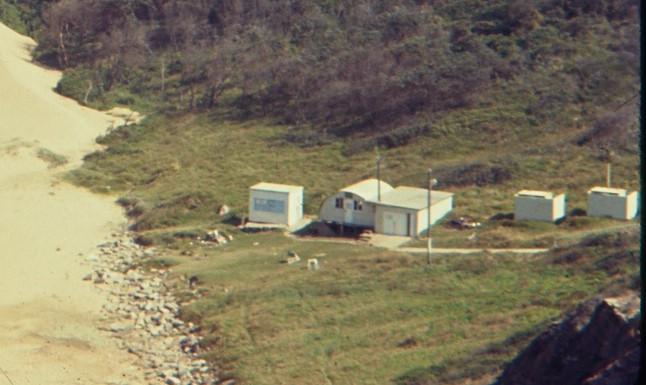
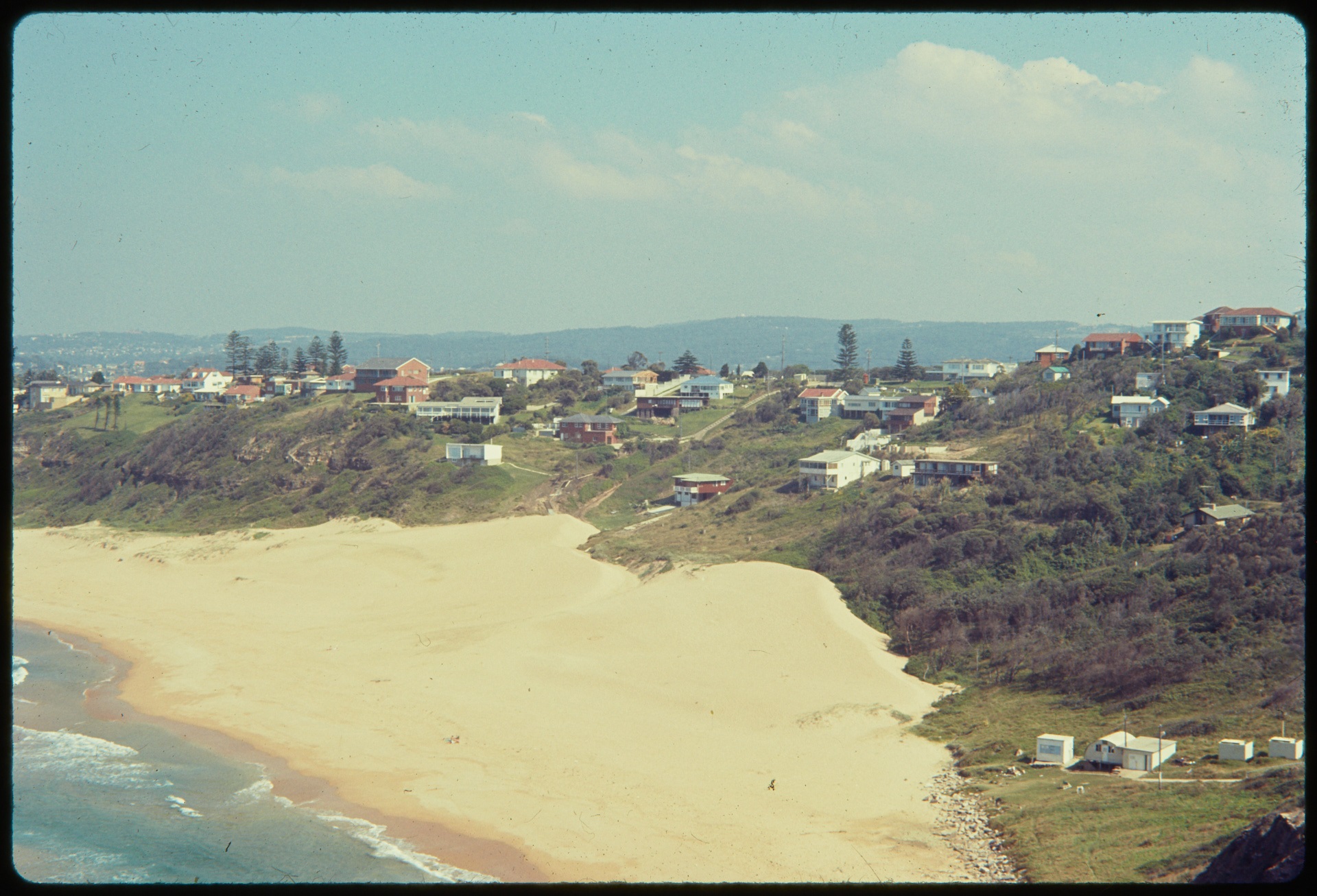
NSW State Records and Archives photos {Ref: NRS-15721-1-1-55] Beach Scenes - Bungan Beach, 15-04-1970 to 19-06-1974
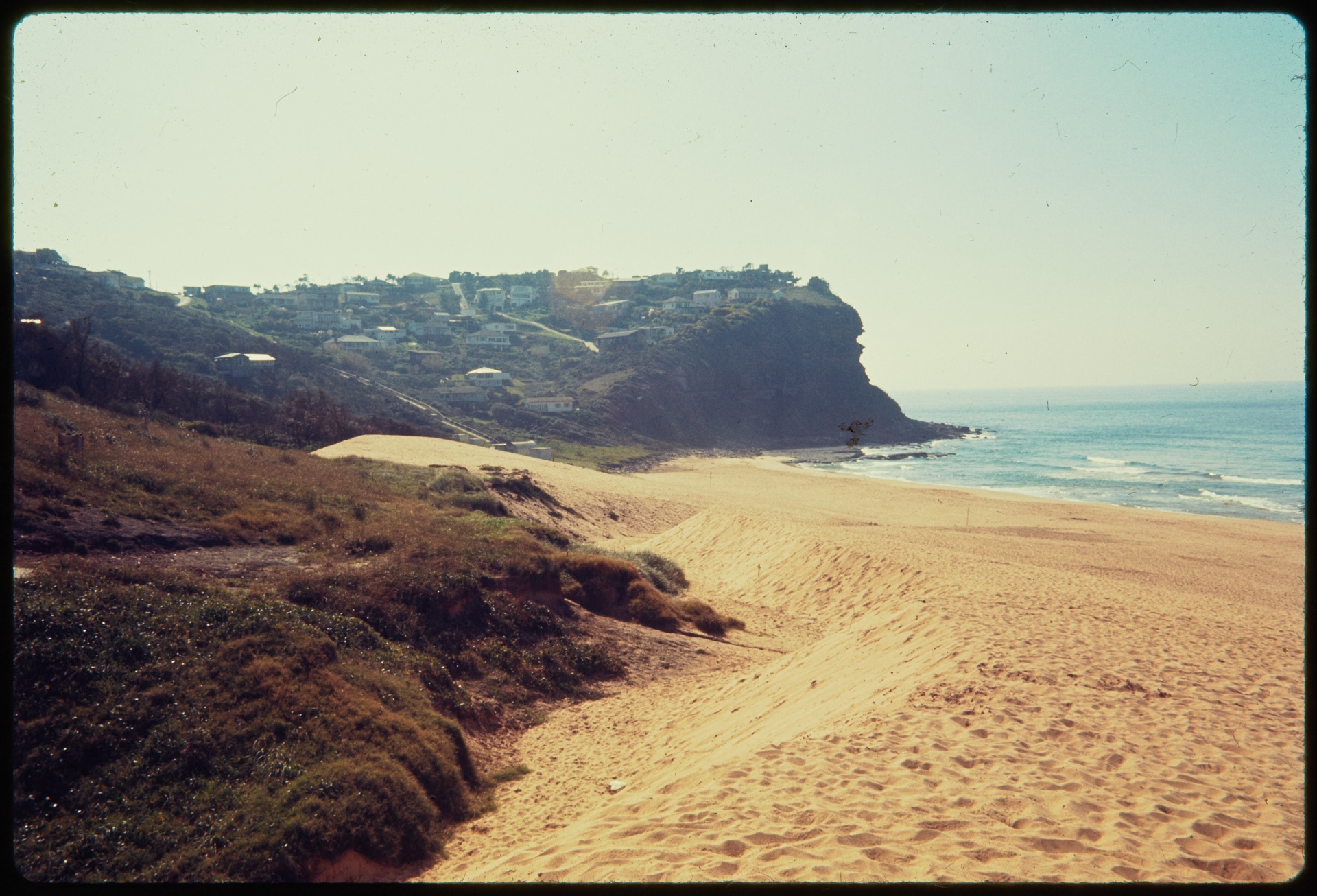
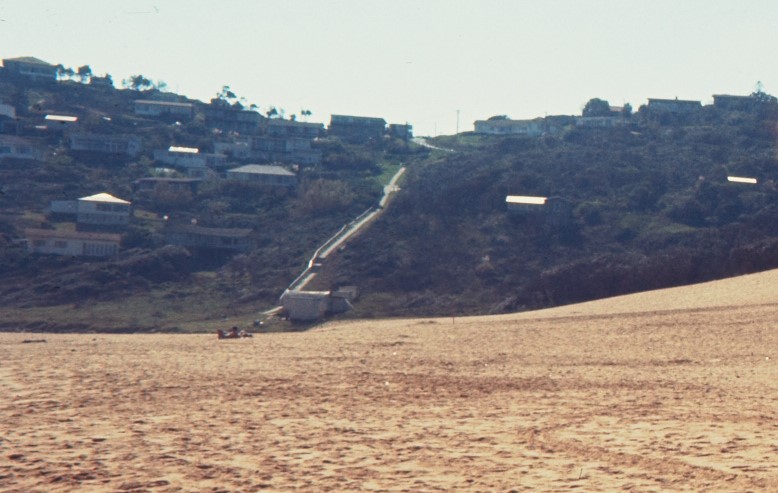
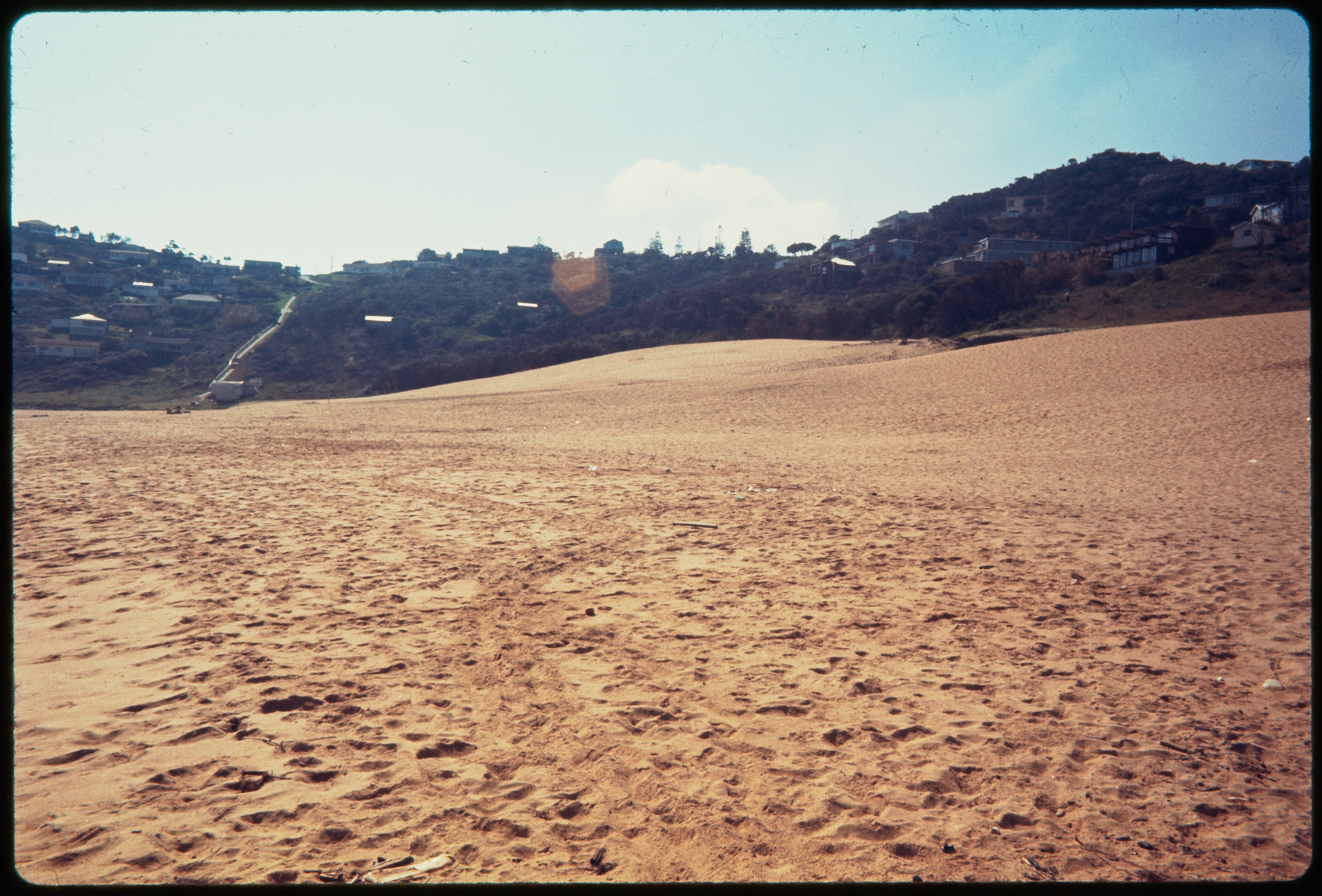
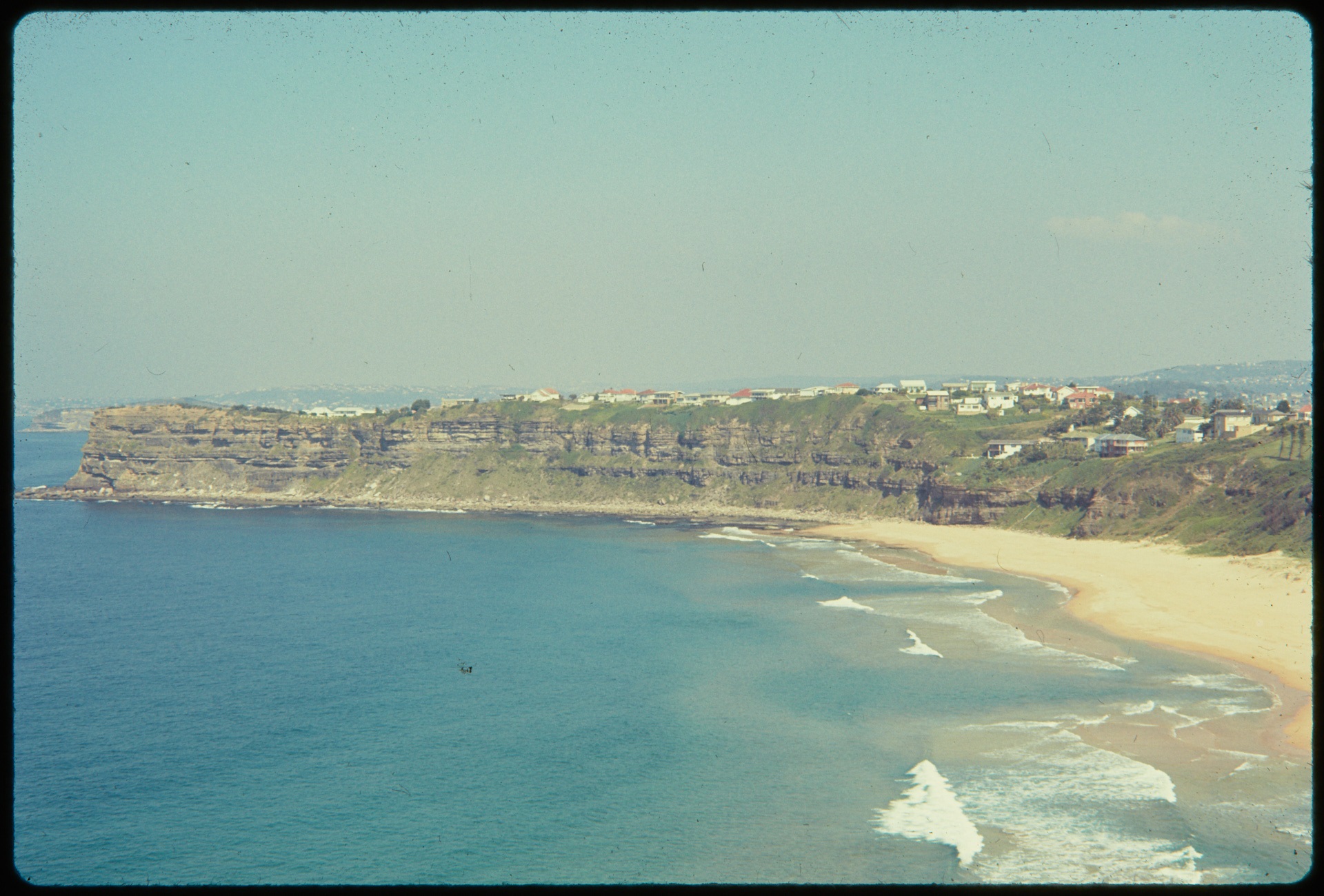
The new club house was short lived. In June 1974 monster waves rose in great fury and closed out the beach. High tides raised the water level and transported the devastating walls of foam that smashed again and again into the front wall of the club house, leaving only a half perimeter wall and a slab of concrete which formed the floor.
Again in June 1974 the fury of the wind and waves rose again unroofing the remaining public dressing sheds and the boatshed as if to finish off the building which housed the men and equipment which saved swimmers in distress. The mess and debris around the club house area was abysmal and a continuing reminder of the devastation.
A liaison committee had been set up to talk with Council and pursue the insurance claim but resolution was slow' It was only during the 1975-76 Season that the building was restored and stands as a Silent monument to years of endeavour.
Fortunately, the days of packing case shelters and worn out Nissen huts are no more and public awareness of the life sawing need would not allow such a struggle to continue for so long in this day and age. However, it is a fact it some of the best years in terms of the ‘club spirit’ were in that ramshackle premises which represented the personal endeavour of so many members of that era.
References
Avalon lifesavers yesterday caught a 12ft 800lb whaler shark which had been cruising off the beach during the holidays. It was caught on a line set from a buoy. Five lifesavers in a surfboat tied the line to the boat and, after fighting with the shark for half an hour, caught a wave to the beach. The shark had a two-foot jaw span. The surf club exhibited it in a marquee. They collected £7 in donations, and then sold the shark as shark steak. The whaler is one of the species of Australian sharks known to attack humans. The North Narrabeen club used shark repellent at their surf carnival yesterday. A boat towed a bag of copper acetate around the swimming area. No sharks were seen during the carnival. Lifesavers Catch Huge Shark. (1949, December 28). The Sydney Morning Herald (NSW : 1842 - 1954), p. 1. Retrieved from http://nla.gov.au/nla.news-article18145086
Bungan (birth), Richmond and Tweed Districts.
Bognl or Banara (good), Richmond and Tweed Districts.
Boongin (heart), Richmond and Tweed Districts.
Royal Anthropological Society of Australasia. (Vol. 12 No. 8 (1 December 1910)). Aboriginal Names and Meanings., Science of man and journal of the Royal Anthropological Society of Australasia Retrieved from http://nla.gov.au/nla.obj-531598511
Young stars shine in surf club film
By Dolly Baverstock
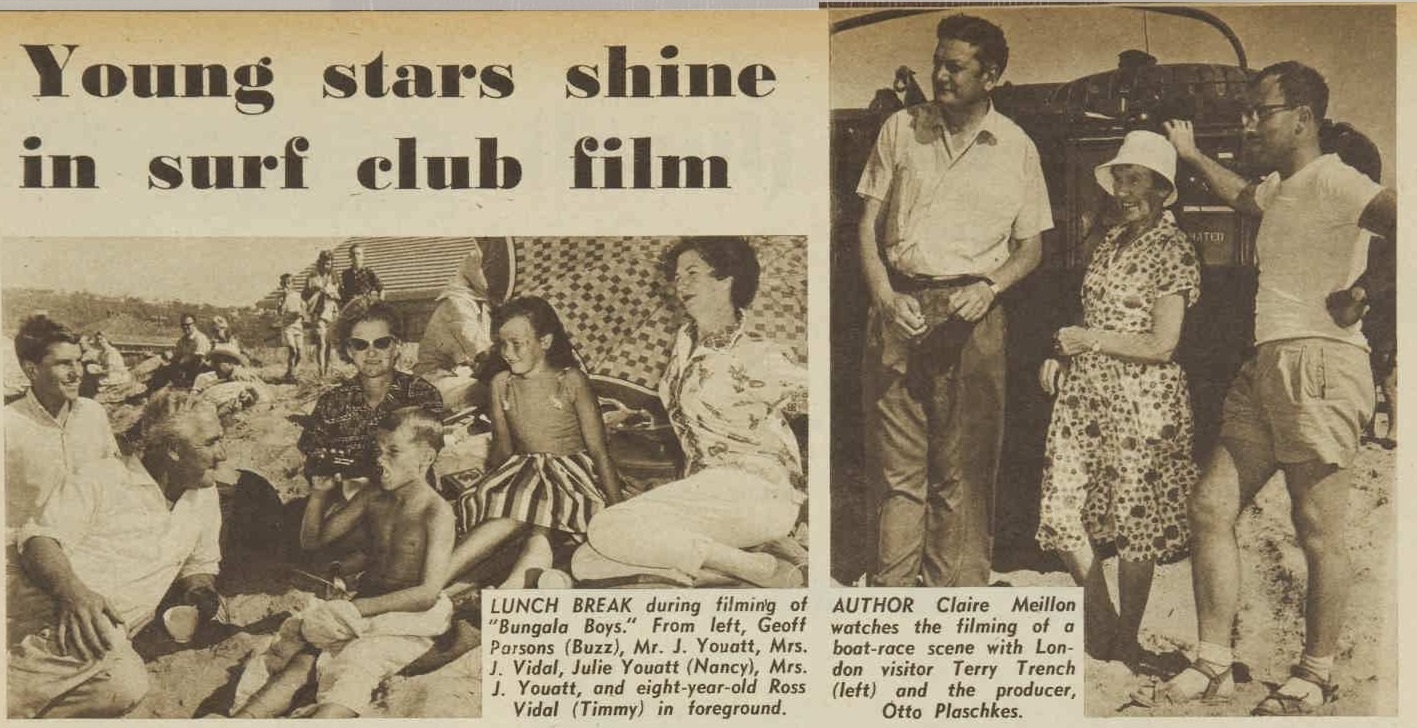
LUNCH BREAK during filming of "Bungala Boys." From left. Geoff Parsons (Buzz), Mr. J. Youatt, Mrs. J. Vidal, Julie Youatt (Nancy), Mrs.J. Youatt, and eight-year-old RossVidal (Timmy) in foreground.
AUTHOR Claire Meillon watches the filming of a boat-race scene with London visitor Terry Trench(left) and the producer, Otto Plaschkes.
Breaking into films sounds easy when Peter Couldwell tells how he came to get the starring role in the new film "Bungala Boys." "I just asked if I could be in it," he said.
AND 14-year-old Peter's reason for seeking the film role is just as simple he wanted money to buy a surfboard.
"Bungala Boys"' is the first Australian non – documentary feature film to be made in wide screen color which has surf clubs and surf club members as the theme of its story.
It is a dramatisation of the novel "The New Surf Club" by Sydney author Claire Meillon, who was formerly assistant fiction editor of The Australian Women's Weekly.
Jimar Productions, of Sydney, has made the film at the request of the Children's Film Foundation of Britain, which will screen it to teenage audiences through-out Britain. Later it will be shown throughout the world."
Its star, Peter Couldwell, a Manly High School pupil, is the son of Mr. and Mrs. A. C. Couldwell, of Harbord, one of Sydney's northern beach suburbs.
'"Dad came home one night with the evening paper and showed me an item in it saying some people were going to make a surfing film and wanted to interview boys for the leading role," Peter said.
"Dad said I should try for it because if I got the role I could afford to buy a surf-board."
Peter's role is Tony Wakeford, a selfish and carefree youngster, eager to have all the advantages of membership of the new little surf club, Bungala, formed by his brother, Brian, but unwilling to accept its responsibilities. His transformation into a responsible and valuable member of the club is the story of the film.
Geoffrey Parsons, aged 14, is another schoolboy movie actor who surprised his parents by getting a role in the film. "He heard about it at his school, Balgowlah High, and went with half a dozen other boys to Artransa Studio, where the cast was being chosen,'" said his mother, Mrs. A. G. Parsons, of Balgowlah.
"To my great surprise he came home carrying the type-script of the role of Buzz, and announced he had got it."
There are older, more experienced actors in the cast, too, but it is the young people who star. They range from eight year-old Ross Vidal, who plays Timmy, and nine-year-old Terry Bentley, as Normie, to Peter Goslett and Dennis Carroll, both aged 22.
Many of them are making their first appearance as actors. Some have acted in children's roles, some in radio and TV, and others have done modelling.
Peter Goslett plays Barney, the brawny young fisherman whose physical strength and genial nature are such an asset to the Bungala Club.
Nineteen - year - old Alan Dearth, son of well-known radio actor Harry Dearth, gave up his job in a Sydney advertising agency to take the role of Brian.
Other Bungala boys are Dennis Carroll and 19-year-old David Broad, who are both doing Arts at Sydney University, and 18-year-old David Sumpter, who is an experienced surfer of the Avalon Surf Club.
Two Sydney .schoolgirls who have leading roles are 11-yearold Julie Youatt, who plays Nancy, and 16-year-old Janice Dinnen, who is Svlvia.
Surf life-saving clubs of the beaches north of Sydney, from Manly to Palm Beach, sent crews and boats to give the authentic touch to surf-carnival and boat-race scenes filmed on location at Bungan Beach, near Newport, and at Narrabeen.
Director Jim Jeffrey, producer Otto Plaschkes, assistant director Bill Lambert, Carl Kayser, director of photography, and their crew of technicians have filmed the boat race scenes from one of the two Army ducks that have been on location with the company.
Wallowing through choppy seas, the duck allows the cam-era to get close-up scenes of the surfboats during the race.
Dominic Brokenshire, Tamarama Surf Club's boat captain, trained the Bungala boys to handle their surfboat, "The Flying Lobster."
Being on location has been a picnic occasion for the parents and friends of the cast, who have brought baskets of food and beach umbrellas and spent the day watching the screening.
There have been all-night sessions, too, at Bungan Beach, when the youngsters, between filming, were wrapped in rugs by their parents and allowed to sleep until called again to take part in a scene in which vandals break into the Bungala club-house and damage the club's cherished surfboat.
Even the bus crews on the route have taken a deep interest in the making of "Bungala Boys."
"'Are you hoping to get into the new film, too?" a bus conductress asked the author of "The New Surf Club" as she asked for a fare to Bungan Beach.
Turn overleaf for color pictures taken on location by staff man Ernie Nutt.
On page 70
Where the (local)boys are
. The beach at South Narrabeen, N.S.W., was "on location" for the boys and girls who form the major part of the cast of the new film "Bungala Boys." Surf club members also took part as extras.
.jpg?timestamp=1714252020392)
THE FLYING LOBSTER-the name of the Bungala Boys's surfboat-leaves the shore and heads through surf to take part in a race. An army duck carried cameramen, director, and technicians to sea to shoot this scene.
.jpg?timestamp=1714252143112)
THE BUNGALA BOYS bring their boat to shore after the race. From left, Peter Barney), David Broad (Douglas), Alan Dearth (Brian), had special training in surfboat racing for the film.
Couldwell (Tony), Peter Gos!em and Dennis Carroll (Lyall).
.jpg?timestamp=1714252259250)
.jpg?timestamp=1714252288677)
RELAXING on the beach between takes are, from left, David Broad, Alan Dearth,Janice Diamen, Dennis Carrol, and Peter Goslett. Sixteen-year-old Janice plays Sylvia in the new film.
.jpg?timestamp=1714252468099)
MARCH PAST. In this surf carnival the Bungala Boys are onlookers in the crowd at right at South Narrabeen
.jpg?timestamp=1714252432712)
DIRECTOR Jim Jeffrey discusses a scene with, from left, R. Bull. W. George, A. Cooksedae. and P. Bull, of South Curl Curl.
Young stars shine in surf club film. (1961, June 28). The Australian Women's Weekly (1933 - 1982), p. 69 Supplement: Teenagers' Weekly. Retrieved from http://nla.gov.au/nla.news-article51383768
The Warringah –Shire Council made an emergency allocation of $20,000 today to save the Bilgola beachfront from further damage by huge seas. The president of Bilgola Beach Preservation Committee, Mr. Frank Wilson, said today that Bilgola Beach had disappeared altogether and seven homes were in danger of being washed into the sea. Ship splits in two as storms continue. (1974, June 12). The Canberra Times (ACT : 1926 - 1995), p. 3. Retrieved from http://nla.gov.au/nla.news-article110782971
AFTERMATH OF A DISASTROUS WEEKEND - Pictures
ABOVE: Before the gale-force tempest hit Sydney, this twisted pile of brick, wood veneer, and electricity wiring was No. 17, The Serpentine, Bilgola. On the beach-sidewalls warnings like "Trespassers will be vigorously prosecuted" had been scrawled in black paint. BELOW: Bird's-eye view of beach homes perched at the edge of the still irritable ocean at Bilgola beach. Even the makeshift seawall looks vulnerable in the path of the incoming tide. High on the cliff above the beach is the wreck of the house pictured above.
These pictures were taken last week as the skies were slowly clearing after the savage weekend of near-cyclonic wind and rain. All the N.S.W. coast was affected, especially the central area. In Sydney alone, damage is estimated at $50 million. Hardest hit were the city beaches, especially along the northern fringe.
LEFT: On Patonga Beach, Central Coast, $13,000 worth of fishing boat was wrecked and washed in to the shore.
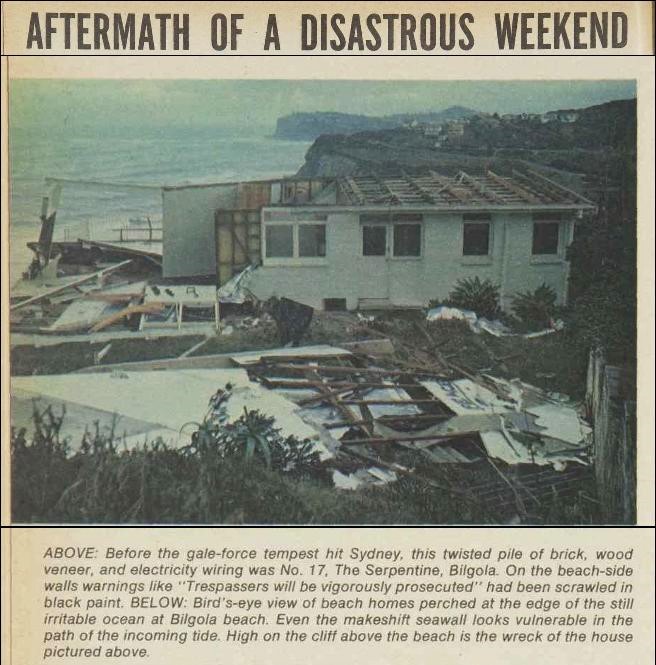
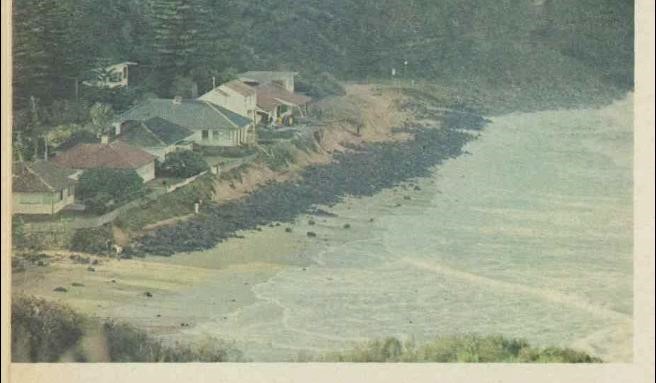
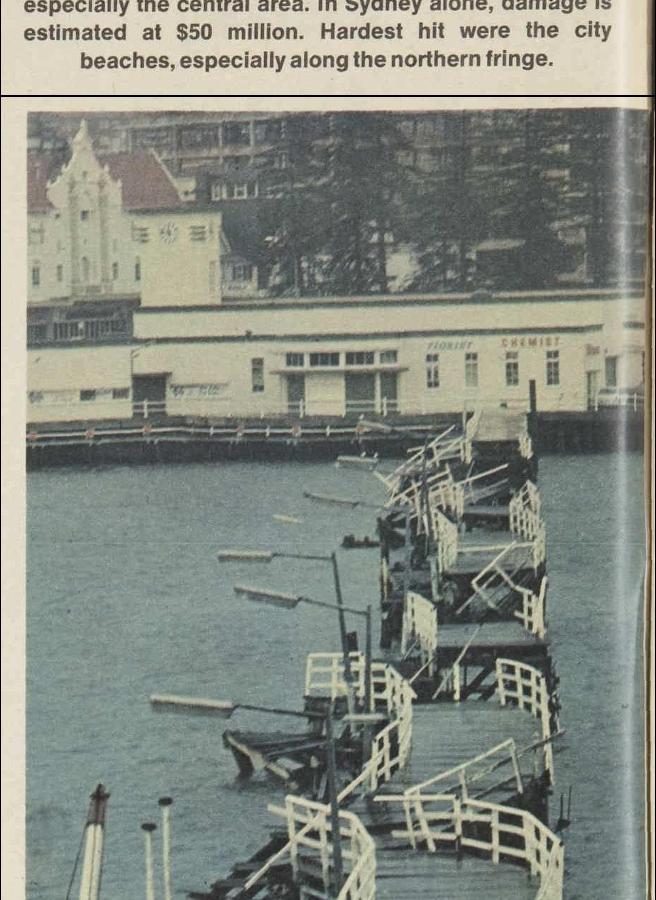
ABOVE: Warning notices about diving or spear-fishing or even riding bicycles cling haphazardly to Manly's storm-twisted promenade. During the height of the storm, the mesh wiring that made the pool shark-proof was torn apart, leaving the pool open to any grey nurse who chooses to drop in. At Manly alone damage is estimated at $50 million.
ABOVE: Splinters of pleasure craft and other pieces of wood drift dejectedly beside the Manly pier. At the devastated Harbour pool on the other side of the pier, members of the Maritime Services Board had worked from 6 a.m. to clean up the debris.
Pictures by Keith Barlow and Neville Waller. BELOW: Foam washed up by heavy seas at Wamberal, on the Central Coast, looks like smouldering smoke. AFTERMATH OF A DISASTROUS WEEKEND. (1974, June 12).The Australian Women's Weekly (1933 - 1982), p. 8. Retrieved from http://nla.gov.au/nla.news-article44557918